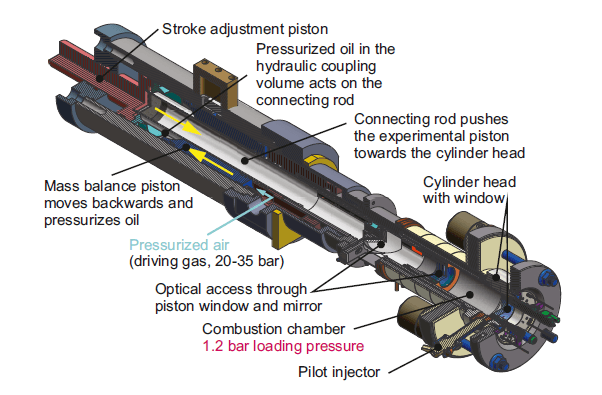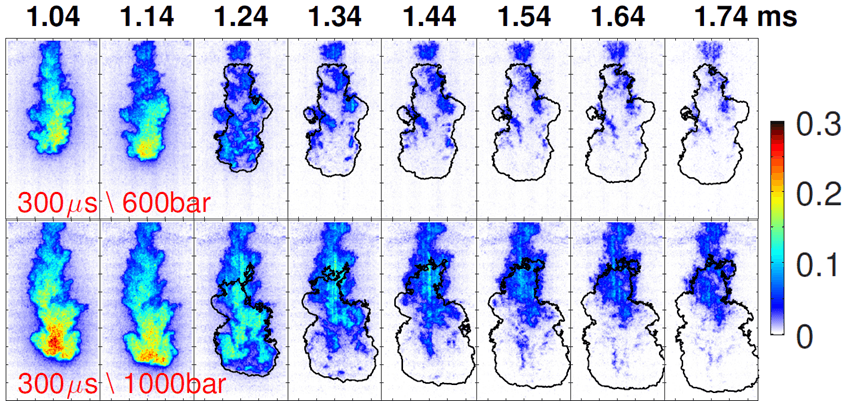19.10.2020
5 minutes of reading
In partnership with Swiss research bodies1, IFPEN conducted a detailed study of the physical mechanisms (initiation and propagation) involved in combustion. Such knowledge is crucial for the optimization of new engine types based on hybrid combustion modes.
Natural gas and diesel: a doubly efficient combination
In the race to develop the most efficient and environmentally-friendly engine possible, an emerging solution is the focus of numerous search studies: the combination of the combustion qualities of natural gas (associated with low greenhouse gas emissions) and those of diesel (characterized by its ease of ignition).
This combination makes it possible to obtain highly efficient hybrid combustion modes in terms of both energy efficiency - in other words, they are associated with low levels of greenhouse gas emissions - and pollutant emissions.
Studying combustion initiation and propagation
However, the physical mechanisms at play are complex. In order to fully optimize these new engine types, it is necessary to have a detailed understanding of the way combustion is initiated and propagates.
It was to this end that ETHZ, PSI and IFPEN teams studied the ignition mechanisms associated with a mixture of air and natural gas with a pilot injection of diesel. They conducted the study via the combined use of optical diagnostics and complex chemistry calculations.
A rapid compression machine for enlightening results
The experimental research was structured around the use of a rapid compression machine (figure 1) developed and operated at ETHZ, and capable of reproducing the conditions encountered in the engine in a controlled manner. With integrated optical access, the machine makes it possible to visualize the evolution over time of the pilot diesel jet, as well as its combustion thanks to different simultaneous laser techniques [1-3], and, in particular, fluorescence techniques.

of dual-fuel combustion ignition mechanisms
The results obtained led to a detailed understanding of the way in which the flame ignites and changes over time (figure 2). The use of advanced diagnostics makes it possible to observe the transition between the self-ignition of the diesel jet and the propagation of the natural gas flame.

in a natural gas environment
Another notable advance to result from this research is a better understanding of the way in which the chemistry of ignition of the pilot diesel jet is affected by the presence of natural gas [4].
This newly acquired knowledge may contribute to the development of future types of dual-fuel engines that are more efficient and cleaner.
1 ETH Zurich and Paul Scherrer Institute
References:
[1] Aleš Srna, Rolf Bombach, Kai Herrmann, Gilles Bruneaux, Characterization of the spectral signature of dual‑fuel combustion luminosity: implications for evaluation of natural luminosity imaging, Applied Physics B (2019) 125:120, https://doi.org/10.1007/s00340-019-7222-z
[2] Aleš Srna, Beat von Rotz, Kai Herrmann, Konstantinos Boulouchos, Gilles Bruneaux, Experimental investigation of pilot-fuel combustion in dual-fuel engines, Part 1: Thermodynamic analysis of combustion phenomena, Fuel, 2019, https://doi.org/10.1016/j.fuel.2019.115642
[3] Aleš Srna, Beat von Rotz, Michele Bolla, Yuri M. Wright, Kai Herrmann, Konstantinos Boulouchos, Gilles Bruneaux, Experimental investigation of pilot-fuel combustion in dual-fuel engines, Part 2: Understanding the underlying mechanisms by means of optical diagnostics, Fuel, 2019, https://doi.org/10.1016/j.fuel.2019.115766
[4] Aleš Srna, Michele Bolla, Yuri M. Wright, Kai Herrmann, Rolf Bombach, Sushant S. Pandurangi, Konstantinos Boulouchos, Gilles Bruneaux, Effect of methane on pilot-fuel auto-ignition in dual-fuel engines, Proceedings of the Combustion Institute (2018), https://doi.org/10.1016/j.proci.2018.06.177
Scientific contact: Gilles Bruneaux
To find out more : Combustion and engines technologies





